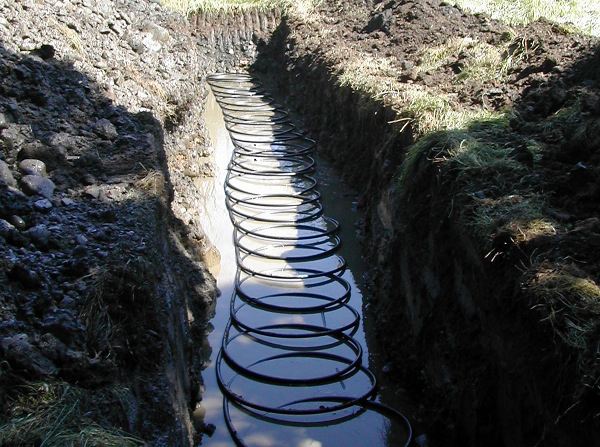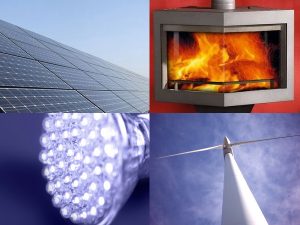Heat pumps - introduction

“We retrofitted our 17th century cottage with ground-source heating. It was an ambitious project, but in retrospect we are really pleased that we did it. The house is now a steady temperature, with warm floors and no draughts. Once installed, a ground-source heating system is pretty much set and forget.” – Simon Lennane, GP, Ross-on-Wye
Contents
What are heat pumps?
A heat pump is simply a device for absorbing heat from one place and transporting it to another. Heat pumps can be used to remove unwanted heat (e.g. a fridge or air conditioning unit) or to transport heat to where it is needed.
A fridge is a good demonstration of how surplus heat (from cooling food) can be extracted and redistributed. In fact in a super-insulated home the heat from the back of a fridge or freezer can contribute significantly to space heating. Heat pumps, fridges and air conditioners work on the same principle – here’s a bit of science. An air conditioner takes heat from inside (even if it’s already cold) and dumps it outside. A heat pump does the opposite. In fact if a heat pump is run in reverse it becomes an air conditioner.

There are different sources that can be used depending on your property. The most easily installed is the air-source heat pump, which fits to the side of a building and draws in the heat from the air outside. Here’s more information on air source heat pumps.
A ground-source heat pump requires a more complex system of pipes to be laid in the garden around a property, which means that it costs more, but is more efficient compared to air-source heat pumps. Water-source heat pumps are also available.
In each case the system has 3 components: the heat pump itself, plus a collector (outside), and a distribution system (inside). Ground-source heat pumps (GSHPs) rely on heat from the sun warming the surrounding land. In the UK, soil maintains a relatively stable temperature of between 8-12°C at a depth of over a metre, even in winter.

The collector or ground loop is simply a closed circuit of pipe, containing a water / antifreeze mix, buried either in a horizontal trench at least 1.2m, but preferably 1.5-2m deep, or in a vertical bore-hole 15-150m deep. The liquid is pumped through the pipes, collecting heat from the surrounding soil, and into the heat pump, usually sited inside the building.
The heat pump itself has 3 parts:
- an evaporator absorbs the heat from the liquid from the ground loop into a refrigerant, then…
- a compressor compresses to the required distribution temperature, then…
- a condenser releases that heat into a tank of water feeding the distribution system.
Since the heat pump will produce circulating temperatures of only 30-45°C, underfloor heating is best (or highly efficient low temperature radiators), with back-up heating if the system is used for domestic hot water.
Excellent explanation of how a heat pump works.
Heat pumps are very much in the news these days, as they’re set to replace gas boilers, helped by government incentives. There’s been criticism of heat pump technology, but what it really boils down to is that they won’t work as well in badly-insulated homes. The priority for home owners should be to make sure the property is well-insulated first, before installing any renewables. Also, we maybe shouldn’t expect to be wearing t-shirts indoors in February; and the technology will improve – in the same way that mpg has improved for cars over the years.
What are the benefits of heat pumps?
Since the heat comes from a renewable source (the sun), heat pumps can help reduce fossil fuel consumption and thus reduce CO2 and other emissions. It must be remembered though, that heat pumps require a reliable electricity supply which may itself come from a non-renewable source. Given that mains electricity is far greener than it was, the saving in CO2 can be quite dramatic. Modern efficient heat pumps can produce enough heat for any household, including hot water. For every 3-4 kW of heat output produced, 1kW of electricity is consumed for the pump and compressor. This is sometimes expressed as being 300-400% efficient, or having a coefficient of performance (CoP) of 3-4.

Running costs are therefore much lower than by direct electric heating. Electric heating is very expensive – the Energy Saving Trust suggest savings of £1000 compared to direct electric heating, and 7 tonnes of CO2 for 100% of space heating and 50% of hot water in a detached property using a 8-12 kW heat pump costing £6000-£12000 (excluding the distribution system).
Suggested savings over other fuels are £750 and 1.8T for oil, £350 and 6.5T for solid fuel, £410 and 1.2T for gas. This shows a relatively small financial benefit over gas, so that if a gas supply is available, the cost of installing a GSHP is much less attractive than an efficient gas-fired condensing boiler (at current gas prices). GSHP running costs are also subject to fluctuations in electricity prices. Using onsite PV or wind generation to pump the system would remove this risk and create a more eco-friendly system. Bear in mind that PV may provide very little in mid-winter.

Other benefits are high reliability with low maintenance costs and long life expectancy (20-25 years for the pump and up to 50 for the ground loop). There is no local combustion or storage of fuel, and the pump unit only occupies the space of a large domestic fridge. It’s quiet and requires no ventilation or flue because it produces no local pollution. Improvements in coolant and refrigerant technology have also reduced the wider impact of these components.
Installing a ground loop for a heat pump for offices – in Alaska! (Heat pumps really work – even in very cold climates.)
What can I do?
Look hard at your circumstances. A heat pump could be for you, particularly if:
- you are planning a new build or major refurbishment (underfloor pipes or high spec radiators essential).
- your property has a very high level of insulation throughout – remember, the heat is distributed at only 30-45°C – some older buildings may not be energy efficient enough.
- there is no mains gas supply (financial benefits are much less compared to gas).
- you have enough land for a horizontal collector trench – probably at least 2 trenches 300mm wide, 40-50m long and 1.8m deep (or shallower and wider) to take a coiled pipe.
- you are on a green electricity tariff (this enhances the environmental benefits).
- you can include onsite electricity generation (e.g. pv or wind) to power the pump.

On densely-built city sites with little land, vertical boreholes from mini-sized drilling rigs are the efficient solution. Vertical boreholes can be charged with heat from solar panels, pumping heat deep down for recovery in winter.
Get professional advice. System design is crucial for GSHPs. This is very project-specific as required output is calculated from the property’s demand (heat loss, water use etc), and collector length matched to output. An oversized heat pump will cost more for no additional benefit, and possibly suffer reduced equipment life and operating efficiency due to frequent cycling. Under-capacity may require more top-up heating.

Heat pumps are going to become the default for new builds. It’s much cheaper and easier to install than to retrofit, and provides a very low-maintenance way of generating heat from pure renewables. Using nearby parks or green spaces would be an ideal way of mixing natural space and renewable heating. If there isn’t space for a horizontal underground collector system, the air source or vertical borehole options could be considered.
Our friend Simon shares his experiences of installing a ground-source heat pump in an old cottage in Herefordshire.
NB: you can apply for up to 100% funding for an air source heat pump installation from our partners Housewrapped.
Specialist(s)
Thanks to Rick Watson and Simon Lennane for information.
The specialist(s) below will respond to queries on this topic. Please comment in the box at the bottom of the page.

John Cantor is the author of Heat Pumps for the Home, and has spent 40 years working with heat pumps. He’s worked with the Centre for Alternative Technology near Machynlleth, where he lives. He blogs here.




9 Comments
hi, is the 100% funding still happening for heat pumps as I have read that the Domestic Renewable Heat Incentive (RHI) scheme is changing at the end of this month and that new schemes commissioned after 31 March will only get £5k towards the cost – not the 7 years of payments?
Yes I think you are correct galacticleader
We are now planning to install an air-source heat pump and the scheme has changed to the Boiler Upgrade Scheme. I’ve noticed the info is a bit suss on some company sites so probably best to go straight to source about the scheme: https://www.gov.uk/apply-boiler-upgrade-scheme.
This is England and Wales only I believe. I’d be interested to know how you get on – pls do post back a comment if you have any success with it. I’ll do the same.
This is a very informative blog, thanks for sharing about heat pumps. I liked it and it is wonderful to know about so many things that are useful for all of us! Thanks a lot for this amazing blog!! If you are looking same kind of valuable information, then can also visit Cannepp.com
Many thanks to the author for shedding light on this topic and empowering readers like me to make informed decisions. Here’s to a future of efficient and comfortable living!
This article provides a clear and concise explanation of heat pumps and their operation, making it easy for readers to understand how these devices work. The comparison between air-source, ground-source, and water-source heat pumps offers valuable insights into their efficiency and installation requirements. Thank you for sharing this informative piece on an important aspect of heating technology. Much appreciated!
he priority for home owners should be to make sure the property is well-insulated first, before installing any renewables. Also, we maybe shouldn’t expect to be wearing t-shirts indoors in February; and the technology will improve – in the same way that mpg has improved for cars over the years.
This is very project-specific as required output is calculated from the property’s demand (heat loss, water use etc), and collector length matched to output. An oversized heat pump will cost more for no additional benefit, and possibly suffer reduced equipment life and operating efficiency due to frequent cycling. Under-capacity may require more top-up heating.
We’ve just had an air source heat pump installed, complete with replacement radiators, solar panels and insulation upgrades. Was very sceptical, but as it was totally cost free on Eco4… (we were on an oil boiler, so…) I agreed to go ahead. I have to say I’m eating my words. Still early days but the house has been kept warm enough 24/7. Radbots on the radiators are supposed to learn how to heat the rooms, I’m not sure how well that’s going, but actually can’t complain… previously we had rooms which were little used which were usually cold (rads turned down to save oil). Now the whole house seems to be warm all the time!
Hi Colin, glad you are pleased with your install. What are your running cost looking like? I am not an expert on Radbots, but they are just what a heat pump does not want. Radbots work by opening up when someone enters the room. That might be fine for a boiler, but to get good energy-efficiency (low running costs) from a heat pump, it needs to run long and low, and it won’t be energy-efficient if set to warm up quickly like a boiler system will. From my experience here looking at quite a lot of Eco4 installs, some are reasonable, but a few are awful. There is however scope for improvements and sometimes just the need for better seting-up and use. Hopefully you one is one of the better ones.
If you think your heat pump is not working as well as it should, Then the installers are your first port of call. However, if this fails, there is a procedure for complaining about Eco4 installs through Trustmark. https://www.trustmark.org.uk/homeowner/support/complaints-process.